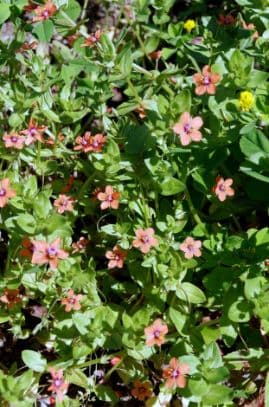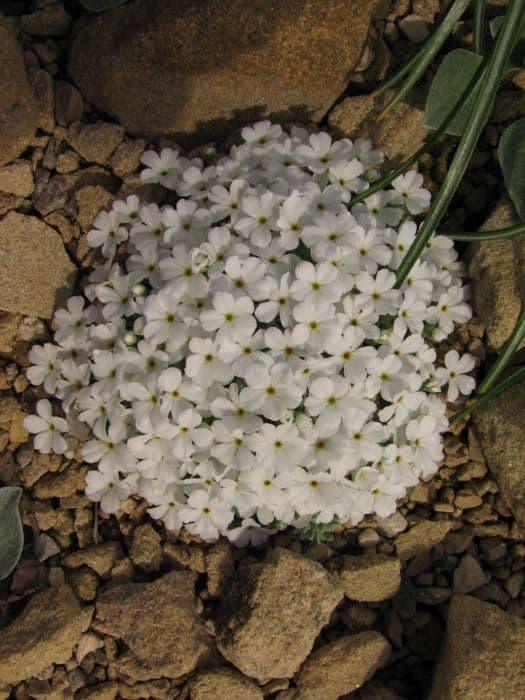Poison Primrose Primula obconica 'Libre Magenta' (Ob)

ABOUT
The Primula obconica 'Libre Magenta', commonly known as the German primrose, exhibits a lush, aesthetic appeal through its vibrant display of magenta flowers. Each bloom presents a rounded shape with a slightly indented margin, giving it a delicate, frilly appearance that adds texture to the visual presentation of the plant. These striking flowers emerge from a rosette of soft green leaves that provide a verdant backdrop to the colorful blossoms. The foliage of the German primrose typically has a slightly fuzzy texture, which creates an interesting tactile experience alongside its visual charm. The plant radiates with its bright, eye-catching hue, making it a popular choice for adding a splash of color to indoor spaces or shaded garden areas.
About this plant
 Names
NamesFamily
Primulaceae
Synonyms
Poison Primrose, German Primrose, Baby Primrose
Common names
Primula obconica 'Libre Magenta' (Ob).
 Toxicity
ToxicityTo humans
The plant known as poison primrose can be toxic to humans due to the presence of a chemical called primin. This compound is found in the plant's hairs and can cause contact dermatitis, which is an allergic skin reaction. Symptoms of this reaction include redness, itching, and blistering of the skin. These reactions are typically localized to the area of contact. It is important to handle the plant with care, using gloves to prevent skin exposure. There is little information about the toxicity of ingesting this plant, but it is generally advised to avoid consuming any part of poison primrose due to its irritant properties.
To pets
Poison primrose is also potentially toxic to pets if they come into contact with the plant. The primin contained in the plant's hairs can lead to dermatitis in animals, much like in humans. If a pet ingests parts of the poison primrose, they may experience symptoms such as drooling, vomiting, or diarrhea, although the primary concern with this plant is usually skin contact. To protect pets from potential poisoning, it is best to keep this plant out of their reach and monitor any interactions they may have with it.
 Characteristics
CharacteristicsLife cycle
Perennials
Foliage type
Evergreen
Color of leaves
Green
Flower color
Magenta
Height
1 foot (30 cm)
Spread
1 foot (30 cm)
Plant type
Herb
Hardiness zones
5
Native area
China
Benefits
 General Benefits
General Benefits- Enhances Aesthetic Appeal: Adds vibrant magenta blooms to gardens and indoor settings, creating a pop of color.
- Long Blooming Season: Flowers from late winter to early spring, providing color during a time when few other plants bloom.
- Attracts Pollinators: Invites beneficial insects such as bees, aiding in the pollination of nearby plants.
- Easy to Grow: Known for being hardy and low-maintenance, making it suitable for novice gardeners.
- Compact Growth: Ideal for container planting or small garden spaces due to its modest size.
- Provides Texture: Its textured leaves add visual interest to garden beds and indoor arrangements.
 Medical Properties
Medical PropertiesThis plant is not used for medical purposes.
 Air-purifying Qualities
Air-purifying QualitiesThis plant is not specifically known for air purifying qualities.
 Other Uses
Other Uses- Photography Prop: The vivid magenta blossoms of the Primula make it a popular choice for photographers seeking a splash of color in spring-themed photo shoots.
- Educational Tool: Biology teachers can use the Primula to demonstrate plant reproductive cycles and flower structure due to its distinct features.
- Artistic Inspiration: Artists may draw inspiration from the Primula's vibrant colors and use it as a subject for paintings, drawings, or textile designs.
- Floral Arrangements: The striking flowers of Primula add depth and vibrancy to floral arrangements and can be used fresh or dried for various decorative purposes.
- Event Decor: Primula can be used as table centerpieces or venue decorations for special events like weddings or garden parties, providing a natural, organic touch.
- Greeting Cards: The image of Primula can be printed or drawn on greeting cards to celebrate springtime events or convey messages of growth and new beginnings.
- Color Dye: The petals of the Primula may be boiled to extract natural pigments for use in fabric or craft dyeing projects, especially for creating a magenta hue.
- Gardening Workshops: Primula can be featured in gardening workshops or demos to teach about caring for flowering plants and cultivating color in home gardens.
- Decorative Wreaths: Dried Primula blooms can be incorporated into decorative wreaths or garlands as a unique touch for door or wall decor.
- Culinary Garnish: Although not commonly used for consumption, Primula flowers can occasionally serve as an edible garnish for dishes, provided they are free of pesticides and not toxic.
Interesting Facts
 Feng Shui
Feng ShuiThe German Primrose is not used in Feng Shui practice.
 Zodiac Sign Compitability
Zodiac Sign CompitabilityThe German Primrose is not used in astrology practice.
 Plant Symbolism
Plant Symbolism- Caution: Primula obconica, commonly known as Poison Primrose, can cause skin irritation due to the primin it contains. Its symbolism often serves as a reminder to handle certain situations or relationships with care, akin to the way one would handle a delicate but potentially irritating plant.
- Perseverance: Originating from China, where it thrives in cool environments, Poison Primrose symbolizes perseverance through tough conditions as it continues to bloom in cooler temperatures when many other plants would wilt or die.
- Variability: With its varying colors, Poison Primrose can represent diversity and the beauty that comes with many forms and perspectives, encouraging an appreciation for variety in life.
- New Beginnings: With its early spring blooming, it can also represent new beginnings or starting over, as it is among the first plants to herald the end of winter and the arrival of spring.
 Water
WaterPoison Primrose should be watered thoroughly whenever the top inch of soil feels dry to the touch, typically every few days to a week, depending on environmental conditions. Use room temperature water, watering directly onto the soil to avoid wetting the leaves and flowers, which can lead to fungal diseases. During active growth in spring and summer, you might find yourself watering approximately one to two gallons per week for a medium-sized pot. Reduce watering in the cooler months to prevent waterlogging, as the plant's water requirements decrease.
 Light
LightPoison Primrose thrives in bright, indirect light away from direct sunlight, which can scorch its leaves. An east- or north-facing windowsill is ideal, as it will provide the gentle morning or filtered light that the plant prefers. Ensure the plant is protected from the harsh afternoon sun, especially during the hottest part of the day.
 Temperature
TemperaturePoison Primrose prefers cool to moderate temperatures, ideally between 60 and 75°F. It can tolerate temperatures as low as 50°F, but prolonged exposure to temperatures below this can be detrimental. Similarly, temperatures above 80°F can stress the plant, so it’s best to avoid placing it near heat sources or in direct sunlight which can raise the ambient temperature excessively.
 Pruning
PruningPrune Poison Primrose to remove spent flowers and encourage blooming, as well as to maintain its shape and size. Deadheading, or removing faded flowers, should be done regularly throughout the blooming period. Cut back the foliage once blooming has ceased, typically in late summer, to rejuvenate the plant for the next season. Always use clean, sharp scissors or pruning shears to make smooth cuts.
 Cleaning
CleaningAs needed
 Soil
SoilThe poison primrose (Ob) prefers a soil mix rich in organic matter, with good drainage, and a slightly acidic to neutral pH between 6.0 and 7.0. A blend of peat moss, loam, and perlite or sand works well to ensure adequate drainage and aeration.
 Repotting
RepottingPoison primrose (Ob) should be repotted annually to replenish the soil and accommodate root growth. It's best to repot in spring before the new growth starts.
 Humidity & Misting
Humidity & MistingPoison primrose (Ob) thrives at a relative humidity level of 50-60%. It prefers moist air but not overly wet conditions, which can be achieved with a room humidifier or by placing a tray of water near the plant.
 Suitable locations
Suitable locationsIndoor
Place in bright, indirect light and keep soil moist for indoor growth.
Outdoor
Plant in partial shade and keep protected from strong winds outdoors.
Hardiness zone
5-9 USDA
 Life cycle
Life cycleThe life cycle of Primula obconica 'Libre Magenta', commonly known as Poison Primrose, begins with seed germination, which occurs under moist, well-lit conditions, typically in the spring. The seedlings develop into rosette-forming juveniles, where they produce a cluster of leaves at the soil surface. As the plants mature, they develop their first flowering stems, heralding the vegetative to the reproductive phase, which is marked by vibrant magenta flowers blooming primarily in late winter to spring. After pollination, often by insects, the flowers develop into seed capsules containing numerous small seeds, completing the reproductive cycle. The parent plant may die after seeding, hence behaving as a biennial, or it may persist and enter a period of dormancy during hot or dry seasons, to regrow when conditions improve. Over time, the plant can also form offsets, which are new shoots that grow from the root system, contributing to its spread and beginning a new cycle of growth.
 Propogation
PropogationPropogation time
Spring-Early Summer
Primula obconica 'Libre Magenta', commonly referred to as German primrose, is conventionally propagated through seeds, as this is the most popular method. Seed sowing should be done in late winter or early spring when temperatures start to warm up slightly. The seeds of German primrose are very fine and should be spread on the surface of a well-draining seed starting mix, as they require light for germination. Care should be taken to maintain the soil's moisture without making it waterlogged. A plastic cover or glass on top of the pot can help retain humidity. Seeds usually germinate within 2 to 3 weeks at temperatures between 60-70 degrees Fahrenheit (15.5-21 degrees Celsius). Once seedlings have developed their first true leaves, they can be carefully transplanted to individual pots or their final location.









